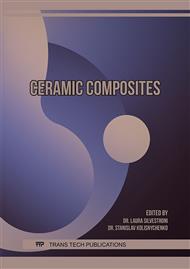[1]
P. Schwingenschlögl, P. Niederhofer, M. Merklein, Investigation on basic friction and wear mechanisms within hot stamping considering the influence of tool steel and hardness, Wear. 426–427 (2019) 378-389.
DOI: 10.1016/j.wear.2018.12.018
Google Scholar
[2]
E. Felder, C. Levrau, Analysis of the lubrication by a pseudoplastic fluid: Application to wire drawing, Tribology International. 44(7–8) (2011) 845-849.
DOI: 10.1016/j.triboint.2011.02.009
Google Scholar
[3]
E. Felder, C. Levrau, M. Mantel, N. G. T. Dinh, Identification of the work of plastic deformation and the friction shear stress in wire drawing, Wear. 286–287 (2012) 27-34.
DOI: 10.1016/j.wear.2011.05.029
Google Scholar
[4]
X. Wang, C. Wang, X. Shen, F. Sun, Tribological properties of diamond films for high-speed drawing Al alloy wires using water-based emulsions, Tribology International. 123 (2018) 92-104.
DOI: 10.1016/j.triboint.2018.03.004
Google Scholar
[5]
M. H. Sulaiman, R. N. Farahana, K. Bienk, C. V. Nielsen, N. Bay, Effects of DLC/TiAlN-coated die on friction and wear in sheet-metal forming under dry and oil-lubricated conditions: Experimental and numerical studies, Wear. 438–439 (2019) Article 203040.
DOI: 10.1016/j.wear.2019.203040
Google Scholar
[6]
M. Nilsson, M. Olsson, Tribological testing of some potential PVD and CVD coatings for steel wire drawing dies, Wear. 273(11) (2011) 55-59.
DOI: 10.1016/j.wear.2011.06.020
Google Scholar
[7]
Fang Y, Fan H, Song J, Zhang Y and Hu L Surface engineering design of Al2O3/Mo self-lubricating structural ceramics - Part II: Continuous lubrication effects of a three-dimensional lubricating layer at temperatures from 25 to 800 °C, Wear. 360–361 (2016) 97-103.
DOI: 10.1016/j.wear.2016.04.023
Google Scholar
[8]
L. Reinert, M. Varenberg, F. Mücklich, S. Suárez, Dry friction and wear of self-lubricating carbon-nanotube-containing surfaces, Wear. 406–407 (2018) 33-42.
DOI: 10.1016/j.wear.2018.03.021
Google Scholar
[9]
D'Angio', J. Zou, J. Binner, H. Ma, W. G. Fahrenholtz, Mechanical properties and grain orientation evolution of zirconium diboride-zirconium carbide ceramics, Journal of the European Ceramic Society. 38 (2) (2018) 391-402.
DOI: 10.1016/j.jeurceramsoc.2017.09.013
Google Scholar
[10]
E. A. Vorotilo, M.I. Levashov, M.I. Petrzhik, D. Yu. Kovalev, Combustion synthesis of ZrB2-TaB2-TaSi2 ceramics with microgradient grain structure and improved mechanical properties, Ceramics International. 45 2A (2019) 1503-1512.
DOI: 10.1016/j.ceramint.2018.10.020
Google Scholar
[11]
Z. Zhao, H. Xiang, F. Dai, Z. Peng, Y. Zhou, On the potential of porous ZrP2O7 ceramics for thermal insulating and wave-transmitting applications at high temperatures, Journal of the European Ceramic Society. 40(3) (2020) 789-797.
DOI: 10.1016/j.jeurceramsoc.2019.11.016
Google Scholar
[12]
N. L. Savchenko, Yu. A. Mirovoy, A. S. Buyakov, A. G. Burlachenko, S. Yu. Tarasov, Adaptation and self-healing effect of tribo-oxidizing in high-speed sliding friction on ZrB2-SiС ceramic composite, Wear. 446–447 (2020) Article 203204.
DOI: 10.1016/j.wear.2020.203204
Google Scholar
[13]
Y. Su, Y. Zhang, J. Song, L. Hu, Tribological behavior and lubrication mechanism of self-lubricating ceramic/metal composites: The effect of matrix type on the friction and wear properties, Wear. 372–373 (2017) 130-138.
DOI: 10.1016/j.wear.2016.12.005
Google Scholar
[14]
G. Zhang, D. Ni, J. Zou, H. Liu, Y. Sakka, Inherent anisotropy in transition metal diborides and microstructure/property tailoring in ultra-high temperature ceramics—A review, Journal of the European Ceramic Society 38(2) (2018) 371-389.
DOI: 10.1016/j.jeurceramsoc.2017.09.012
Google Scholar
[15]
J.H. Ouyang, Y.F. Li, Y. M. Wang, Y. Zhou, S. Sasaki, Microstructure and tribological properties of ZrO2(Y2O3) matrix composites doped with different solid lubricants from room temperature to 800°C, Wear. 267(9-10) (2009) 1353-1360.
DOI: 10.1016/j.wear.2008.11.017
Google Scholar
[16]
E.W. Neuman, G.E. Hilmas, W. G. Fahrenholtz, Mechanical behavior of zirconium diboride–silicon carbide–boron carbide ceramics up to 2200°C, Journal of the European Ceramic Society. 35(2) (2015) 463-476.
DOI: 10.1016/j.jeurceramsoc.2014.09.021
Google Scholar
[17]
L.I. Kuksenova, V.G. Lapteva, A.G. Kolmakov, L.M. Rybakova, Methods of testing for friction and wear, Intermet engineering. Moscow, (2001).
Google Scholar
[18]
V.S. Yakushkina, E.A. Korableva, N.N. Savanina, L.I. Kuksenova, V. G. Lapteva, V.V. Alisin, The influence of agglomeration technology on the durability of ceramics made from nanostructured PSZ powders, Journal of Machinery Manufacture and Reliability. 39(1) (2010) 73-77.
DOI: 10.3103/s1052618810010115
Google Scholar



